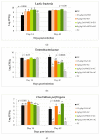Targeted-Release Organic Acids and Essential Oils Improve Performance and Digestive Function in Broilers Under a Necrotic Enteritis Challenge
- PMID: 32041160
- PMCID: PMC7070292
- DOI: 10.3390/ani10020259
Targeted-Release Organic Acids and Essential Oils Improve Performance and Digestive Function in Broilers Under a Necrotic Enteritis Challenge
Abstract
An experiment was performed to evaluate the effect of four different microencapsulated blends of organic acids (OA) and nature-identical aromatic compounds (AC) on growth performance and gut health of broilers challenged with a recycled NE litter. A total of 600 one-day-old male Ross 308 broilers were randomly assigned to five treatments consisting of a basal diet (as negative control) supplemented with each of the tested microencapsulated blends: OA1 (malic and fumaric acid) + AC; 2.5 g/kg; OA2 (calcium butyrate+fumaric acid) + AC; 1.7 g/kg; MCFA (capric-caprylic; caproic and lauric acid) + AC; 2 g/kg; and MCFA + OA3(calcium butyrate + fumaric and citric acid) + AC; 1.5 g/kg. The AC used was the same for all treatments; including cinnamaldehyde, carvacrol, and thymol (8:1:1), as major compounds. Three tested blends enhanced growth performance by improving intestinal histomorphology (p < 0.001). The tested blends enhanced the abundance of some beneficial families such as Ruminococcaceae and Lachnospiraceae; while reducing that of harmful ones such as Enterobacteriaceae and Helicobacteraceae. A further dose-response experiment showed that 0.5 g/kg of the blend 2 and 2 g/kg of the blend 4 improved growth performance and intestinal histomorphology of chickens on d 42 and decreased fecal Enterobacteriaceae and C. perfringens counts. Similar effects to the previous experiment were observed for cecum microbiota.
Keywords: broiler; essential oils; gut health; intestinal histomorphology; microbiota; microencapsulation; organic acids; performance.
Conflict of interest statement
The authors declare no conflict of interest.
Figures














Similar articles
-
Organic acid blends improve intestinal integrity, modulate short-chain fatty acids profiles and alter microbiota of broilers under necrotic enteritis challenge.Anim Nutr. 2022 Mar;8(1):82-90. doi: 10.1016/j.aninu.2021.04.003. Epub 2021 Sep 14. Anim Nutr. 2022. PMID: 34977378 Free PMC article.
-
Microencapsulation Improved Fumaric Acid and Thymol Effects on Broiler Chickens Challenged With a Short-Term Fasting Period.Front Vet Sci. 2021 Oct 15;8:686143. doi: 10.3389/fvets.2021.686143. eCollection 2021. Front Vet Sci. 2021. PMID: 34722691 Free PMC article.
-
Supplementation with organic acids showing different effects on growth performance, gut morphology, and microbiota of weaned pigs fed with highly or less digestible diets.J Anim Sci. 2018 Jul 28;96(8):3302-3318. doi: 10.1093/jas/sky197. J Anim Sci. 2018. PMID: 29762726 Free PMC article.
-
Short and Medium Chain Fatty Acids and Their Derivatives as a Natural Strategy in the Control of Necrotic Enteritis and Microbial Homeostasis in Broiler Chickens.Front Vet Sci. 2021 Dec 14;8:773372. doi: 10.3389/fvets.2021.773372. eCollection 2021. Front Vet Sci. 2021. PMID: 34970616 Free PMC article. Review.
-
Microbial shifts associated with necrotic enteritis.Avian Pathol. 2016 Jun;45(3):308-12. doi: 10.1080/03079457.2016.1152625. Avian Pathol. 2016. PMID: 26950294 Review.
Cited by
-
Elevated levels of butyric acid in the jejunum of an animal model of broiler chickens: from early onset of Clostridium perfringens infection to clinical disease of necrotic enteritis.J Anim Sci Biotechnol. 2024 Nov 2;15(1):144. doi: 10.1186/s40104-024-01105-5. J Anim Sci Biotechnol. 2024. PMID: 39487547 Free PMC article.
-
Effect of organic acids-essential oils blend and oat fiber combination on broiler chicken growth performance, blood parameters, and intestinal health.Anim Nutr. 2021 Dec;7(4):1039-1051. doi: 10.1016/j.aninu.2021.02.001. Epub 2021 May 24. Anim Nutr. 2021. PMID: 34738034 Free PMC article.
-
Effect of coated organic acids on growth performance, Clostridium perfringens colonization, gut integrity and immune response in broilers challenged with subclinical necrotic enteritis.Poult Sci. 2025 Jun 28;104(10):105504. doi: 10.1016/j.psj.2025.105504. Online ahead of print. Poult Sci. 2025. PMID: 40628145 Free PMC article.
-
Effect of an Alliaceae Encapsulated Extract on Growth Performance, Gut Health, and Intestinal Microbiota in Broiler Chickens Challenged with Eimeria spp.Animals (Basel). 2023 Dec 18;13(24):3884. doi: 10.3390/ani13243884. Animals (Basel). 2023. PMID: 38136921 Free PMC article.
-
Dietary Oregano Essential Oil Supplementation Influences Production Performance and Gut Microbiota in Late-Phase Laying Hens Fed Wheat-Based Diets.Animals (Basel). 2022 Nov 2;12(21):3007. doi: 10.3390/ani12213007. Animals (Basel). 2022. PMID: 36359131 Free PMC article.
References
-
- Sokale A.O., Menconi A., Mathis G.F., Lumpkins B., Sims M.D., Whelan R.A., Doranalli K. Effect of Bacillus subtilis DSM 32315 on the intestinal structural integrity and growth performance of broiler chickens under necrotic enteritis challenge. Poult. Sci. 2019;98:5392–5400. doi: 10.3382/ps/pez368. - DOI - PubMed
-
- The True Cost of Necrotic Enteritis. [(accessed on 18 December 2019)]; Available online: https://www.poultryworld.net/Meat/Articles/2015/10/The-true-cost-of-necr...
-
- Latorre J.D., Adhikari B., Park S.H., Teague K.D., Graham L.E., Mahaffey B.D., Baxter M.F.A., Hernandez-Velasco X., Kwon Y.M., Ricke S.C., et al. Evaluation of the Epithelial Barrier Function and Ileal Microbiome in an Established Necrotic Enteritis Challenge Model in Broiler Chickens. Front. Vet. Sci. 2018;5:1–11. doi: 10.3389/fvets.2018.00199. - DOI - PMC - PubMed
LinkOut - more resources
Full Text Sources
Research Materials

